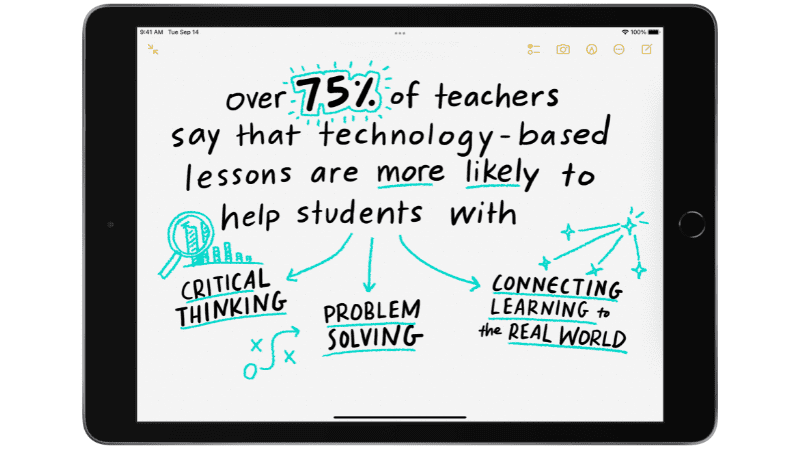Leading a school through a pandemic has its challenges, but it has also given school leaders an opportunity to use technology to help teachers engage students in new ways—like nurturing their creativity. A 2019 Gallup report, “Creativity in Learning,” found that students learn more when they get to be creative with technology.
We wanted to find out how schools have used technology this past year to support creativity, so we spoke with two school leaders, who are also Apple Distinguished Educators: Principal Jeana Lietz and Assistant Principal Dr. Samantha L. Dias. They shared exciting ways that their schools have used technology for at-home learning, as well as how they plan to use technology and creativity to meet individual student needs as learning transitions back to campus this fall.
1. Students choose how they show what they’ve learned.
Before the pandemic, most learning took place in physical classrooms, and many students showed what they learned with paper and pencil. “We had to rethink and reimagine what learning and assessments would look like last year,” Samantha said. Samantha’s school gave students opportunities to show what they learned in different ways, which encouraged their creativity and made assessments more inclusive. Samantha shared that, instead of taking a quiz on the life cycle of a butterfly, “students used iPad to go outside and capture images of the life cycle of a butterfly.”
2. Connecting with others creates memorable learning experiences.
Before students were learning from home, many teachers weren’t using technology to its fullest potential. The Gallup study reported that 41 percent of teachers and 68 percent of students said they use technology to write papers. Only 13 percent of teachers and 25 percent of students said that they used technology in school to experience something they otherwise couldn’t have.
At Samantha’s school, kindergarteners and first graders connected with a ninth-grade class in Japan. They took pictures of inanimate objects on iPad and emailed them to the students in Japan, who then used them to create an animated interactive book. “This is something our kids will remember for a lifetime because they created and collaborated with other students from around the world.”
3. Everyone is a teacher and a student.
At Samantha and Jeana’s schools, teachers and students get to learn from each other. For example, at Samantha’s school, first graders created Clips videos every week to teach their teachers Spanish. Students created tutorials for the school website to support families and caregivers during at-home learning. Students feel empowered when they realize they can use technology to create something that others can learn from.
4. When creativity is encouraged, students are more engaged.
At Samantha’s school, teachers and staff found that when they used lessons that integrated technology in a meaningful way and tapped into students’ interests and passions, students were highly engaged and learned more. Jeana encourages teachers at her school to find out what their students are excited about and give them opportunities to use iPad to express their excitement creatively.
Educators can establish a culture of creativity in classrooms by making time and space for students to share their interests and hobbies. When teachers make time to get to know students and build community, students feel safe taking creative risks.
At Jeana’s school, students started the new school year with what they call Unit Zero—a week focused on building relationships and creating a strong classroom culture. This reserves time for teachers to encourage creativity and engage students.
5. Design a creative culture for your school.
Students benefit the most from using technology for creativity when it’s part of their school culture and happens consistently and systemically, not just every once in a while. For example, Samantha’s school has its annual Everyone Can Create Celebration on the first Friday in March. Students look forward to this event. It’s just one of many opportunities throughout the year when teachers, students, and staff share and celebrate their creative work.
If you’re looking for ways to bring creativity into your school culture, check out 30 Creative Activities For Kids, and 30 More Creative Activities For Kids.
6. Technology is more than a screen.
Jeana believes students spend enough time passively staring at screens, especially this past year. “It’s important to me that students learn how to use iPad as more than a screen or substitute.” She helps teachers use the free Keynote and Pages apps to create engaging lessons that encourage interaction and creativity rather than a passive “sit and get” experience.
One lesson idea is to pick a letter or color of the day and invite students to take a photo walk. Another idea is to ask students to explain the steps in a process, like how to make a sandwich or wash your hands, using the Voice Memos app.
7. Students have a growth mindset.
“Creativity is messy. It isn’t a one-size-fits-all model for a school. It requires students to take ownership of their learning,” says Samantha. “We have a school culture where students are encouraged to have a growth mindset.”
One way that school leaders can use technology to support student creativity is to emphasize the learning process over the product. Instead of writing a paragraph about the weather, for example, students can describe the forecast in a short video using props and photos.
Discover more ideas for using technology to support student creativity.
For more highlights from Gallup’s “Creativity in Learning” study, check out Apple’s Creativity in Learning overview.

